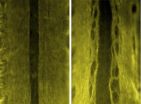(Press-News.org) Researchers at the Bellvitge Biomedical Research Institute (IDIBELL) have described a new selective target in muscle regeneration. This is the association of alpha-enolase protein and plasmin. The finding could be used to develop new treatments to regenerate muscular injuries or dystrophies. The study has been published in PLOS ONE journal.
Skeletal muscle has a great regeneration capacity after injury or genetic diseases such as Duchenne muscular dystrophy, the most common neuromuscular disorder in children. This condition is due to a defect in the gene of dystrophin, which absence causes instability of the membrane and leads to degeneration of muscle fibres.
Regeneration involves the restructuration of the muscular tissue and it requires the participation of extracellular enzymes such as plasmin. The alpha-enolase, an enzyme found in the cytoplasm of cells, enables the activity of plasmin on the cell membrane giving the cell the ability to degrade the surrounding tissue.
In this study, IDIBELL researchers show that the association of alpha-enolase and plasmin regulates two connected processes in the injured muscle or dystrophy: first, the attraction (recruitment) of immune cells to remove damaged tissue and, on the other hand, the formation of new muscle tissue from the stem cells. The researchers observed in the laboratory that these stem cells lost the ability to activate and merge to form skeletal muscle fibers when specific inhibitors of the alfa-enolasa/plasmina union were applied.
The researchers also performed experiments in mice with Duchenne muscular injury. When the animals were treated with the same inhibitors, mice showed a significant defect in muscle regeneration.
"These results demonstrate that the interaction of alpha-enolase and plasmin is necessary for the restoration of damaged muscle tissue", explained Roser López-Alemany, IDIBELL researcher and study coordinator.
Recently, an extensive proteomic meta-analysis identified the alpha-enolase as the first differentially expressed protein in both human pathologies and mouse models, suggesting that "it may be considered a marker of a pathological stress in a large number of diseases", said Lopez-Alemany.
###This study indicates that the association alfa-enolase/plasmin is a novel selectively target for therapeutic interventions in muscle pathologies because "alpha-enolase is responsible for plasmin activity associated with muscle regeneration", concluded the IDIBELL researcher.
Reference of the paper
Díaz-Ramos À, Roig-Borrellas A, García-Melero A, Llorens A, López-Alemany R. Requirement of Plasminogen Binding to Its Cell-Surface Receptor α-Enolase for Efficient Regeneration of Normal and Dystrophic Skeletal Muscle. PLoS ONE 7(12): e50477.
Described a key mechanism in muscle regeneration
The association alfa-enolase/plasmin is a new selectively target for treating muscular pathologies
2012-12-19
ELSE PRESS RELEASES FROM THIS DATE:
Experiencing discrimination increases risk-taking, anger, and vigilance
2012-12-19
Experiencing rejection not only affects how we think and feel — over the long-term it can also influence our physical and mental health. New research suggests that when rejection comes in the form of discrimination, people respond with a pattern of thoughts, behaviors, and physiological responses that may contribute to overall health disparities.
"Psychological factors, like discrimination, have been suggested as part of the causal mechanisms that explain how discrimination gets 'under the skin' to affect health," says psychological scientist and senior researcher Wendy ...
UC Irvine study of leaping toads reveals muscle-protecting mechanism
2012-12-19
Irvine, Calif., Dec. 19, 2012 — Most people are impressed by how a toad jumps. UC Irvine biologist Emanuel Azizi is more impressed by how one lands.
An assistant professor of ecology & evolutionary biology who specializes in muscle physiology and biomechanics, Azizi found that nature's favorite leapers possess a neuromuscular response that's specific to the intensity of a landing – a mechanism that protects muscles from injury upon impact.
The research is helping reveal how the nervous system modulates motor control patterns involved with jumping and landing. Azizi's ...
Healthy lifestyle during menopause may decrease breast cancer risk later on
2012-12-19
Obese, postmenopausal women are at greater risk for developing breast cancer and their cancers tend to be more aggressive than those in lean counterparts. A University of Colorado Cancer Center study published in the December issue of the journal Cancer Research shows how this risk might be prevented.
"By using nutrient tracers for fat and sugar, we tracked where the body stored excess calories. In lean models, excess fat and glucose were taken up by the liver, mammary and skeletal tissues. In obese models, excess fat and glucose were taken up by tumors, fueling their ...
Protein creates paths for growing nerve cells
2012-12-19
Working with mice, Johns Hopkins scientists have discovered that a particular protein helps nerve cells extend themselves along the spinal cord during mammalian development. Their results shed light on the subset of muscular dystrophies that result from mutations in the gene that holds the code for the protein, called dystroglycan, and also show how the nerve and muscle failings of the degenerative diseases are related.
As mammals like mice and humans develop, nerve cells in the brain and spinal cord must form connections with themselves and with muscles to assure proper ...
Small, portable sensors allow users to monitor exposure to pollution on their smart phones
2012-12-19
Computer scientists at the University of California, San Diego have built a small fleet of portable pollution sensors that allow users to monitor air quality in real time on their smart phones. The sensors could be particularly useful to people suffering from chronic conditions, such as asthma, who need to avoid exposure to pollutants.
CitiSense is the only air-quality monitoring system capable of delivering real-time data to users' cell phones and home computers—at any time. Data from the sensors can also be used to estimate air quality throughout the area where the ...
Host cholesterol secretion likely to influence gut microbiota
2012-12-19
For more than half a century, researchers have known that the bacteria that colonize the gastrointestinal tract of mammals influence their host's cholesterol metabolism. Now, Jens Walter and colleagues of the University of Nebraska show that changes in cholesterol metabolism induced by diet can alter the gut flora. The research was published online ahead of print in the journal Applied and Environmental Microbiology.
In the study, the researchers added plant sterol esters to the diets of hamsters. The overall effect of this was to inhibit several bacterial taxa, from ...
Tracking the origins of HIV
2012-12-19
URBANA – Human immunodeficiency virus (HIV) may have affected humans for much longer than is currently believed. Alfred Roca, an assistant professor in the College of Agricultural, Consumer and Environmental Sciences at the University of Illinois, thinks that the genomes of an isolated West African human population provide important clues about how the disease has evolved.
HIV is thought to have originated from chimpanzees in central Africa that were infected with simian immunodeficiency virus (SIV), a retrovirus. "If you look at the diversity present across SIV in chimpanzees, ...
Are we closing in on dark matter?
2012-12-19
This fall, the Kavli Institute for Cosmological Physics at the University of Chicago and the National Academy of Sciences organized a colloquium that brought together more than 100 cosmologists, particle physicists and observational astrophysicists – three fields now united in the hunt to determine what is dark matter. Their goal: to take stock of the latest theories and findings about dark matter, assess just how close we are to detecting it and spark cross-disciplinary discussions and collaborations aimed at resolving the dark matter puzzle.
So where do things stand? ...
MRIs reveal signs of brain injuries not seen in CT scans, UCSF/SFGH researchers report
2012-12-19
Hospital MRIs may be better at predicting long-term outcomes for people with mild traumatic brain injuries than CT scans, the standard technique for evaluating such injuries in the emergency room, according to a clinical trial led by researchers at the University of California, San Francisco (UCSF) and the San Francisco General Hospital and Trauma Center (SFGH).
Published this month in the journal Annals of Neurology, the study was led by UCSF neuroradiologist Esther Yuh, MD, PhD and followed 135 people treated for mild traumatic brain injuries over the past two years ...
Penn metamaterials experts show a way to reduce electrons' effective mass to nearly 0
2012-12-19
PHILADELPHIA — The field of metamaterials involves augmenting materials with specially designed patterns, enabling those materials to manipulate electromagnetic waves and fields in previously impossible ways. Now, researchers from the University of Pennsylvania have come up with a theory for moving this phenomenon onto the quantum scale, laying out blueprints for materials where electrons have nearly zero effective mass.
Such materials could make for faster circuits with novel properties.
The work was conducted by Nader Engheta, the H. Nedwill Ramsey Professor of Electrical ...
LAST 30 PRESS RELEASES:
Making lighter work of calculating fluid and heat flow
Normalizing blood sugar can halve heart attack risk
Lowering blood sugar cuts heart attack risk in people with prediabetes
Study links genetic variants to risk of blinding eye disease in premature infants
Non-opioid ‘pain sponge’ therapy halts cartilage degeneration and relieves chronic pain
AI can pick up cultural values by mimicking how kids learn
China’s ecological redlines offer fast track to 30 x 30 global conservation goal
Invisible indoor threats: emerging household contaminants and their growing risks to human health
Adding antibody treatment to chemo boosts outcomes for children with rare cancer
Germline pathogenic variants among women without a history of breast cancer
Tanning beds triple melanoma risk, potentially causing broad DNA damage
Unique bond identified as key to viral infection speed
Indoor tanning makes youthful skin much older on a genetic level
Mouse model sheds new light on the causes and potential solutions to human GI problems linked to muscular dystrophy
The Journal of Nuclear Medicine ahead-of-print tip sheet: December 12, 2025
Smarter tools for peering into the microscopic world
Applications open for funding to conduct research in the Kinsey Institute archives
Global measure underestimates the severity of food insecurity
Child survivors of critical illness are missing out on timely follow up care
Risk-based vs annual breast cancer screening / the WISDOM randomized clinical trial
University of Toronto launches Electric Vehicle Innovation Ontario to accelerate advanced EV technologies and build Canada’s innovation advantage
Early relapse predicts poor outcomes in aggressive blood cancer
American College of Lifestyle Medicine applauds two CMS models aligned with lifestyle medicine practice and reimbursement
Clinical trial finds cannabis use not a barrier to quitting nicotine vaping
Supplemental nutrition assistance program policies and food insecurity
Switching immune cells to “night mode” could limit damage after a heart attack, study suggests
URI-based Global RIghts Project report spotlights continued troubling trends in worldwide inhumane treatment
Neutrophils are less aggressive at night, explaining why nighttime heart attacks cause less damage than daytime events
Menopausal hormone therapy may not pose breast cancer risk for women with BRCA mutations
Mobile health tool may improve quality of life for adolescent and young adult breast cancer survivors
[Press-News.org] Described a key mechanism in muscle regenerationThe association alfa-enolase/plasmin is a new selectively target for treating muscular pathologies

